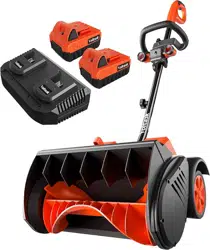Loading ...
Loading ...
Loading ...

Information About the Charger and the Charging Process
.
BATTERY AND CHARGER SAFETY INSTRUCTIONS 09
Protection From Environmental Influences
SS-40A
1.
2.
3.
4.
5.
6.
7.
8.
9.
10.
11.
12.
Please check the data marked on the rating plate of the battery charger. Be sure to connect the battery
charger to a power supply with the same voltage marked on the rating plate. Never connect the charger to a
different voltage.
Protect the battery charger and its cord from damage. Keep the charger and its cord away from heat, oil,
and sharp edges.
Electrical plugs must match the socket. Never modify the plug in any way. Do not use any adapter plugs
with grounded appliances. Unmodified plugs and matching sockets will reduce the risk of electric shock.
Keep the battery charger, battery pack(s), and cordless tool itself out of the reach of children.
Do not use the supplied battery charger to charge other Voltask cordless tools unless indicated as
compatible by the manufacturer.
During periods of heavy use, the battery pack will become warm. Allow the battery pack to cool to room
temperature before inserting it into the charger to recharge.
Do not overcharge batteries. Do not exceed the maximum charging times. These charging times apply only
to discharged batteries. Frequent insertion of a charged or partially charged battery pack will result in
overcharging and cell damage. Do not leave batteries in the charger for days on end.
Never use or charge batteries if you suspect that it has been more than 12 months since the last time they
were charged. There is a high probability that the battery pack has already suffered serious and dangerous
damage (exhaustive discharge).
Charging batteries at a temperature below 41℉/5℃ will cause chemical damage to the cells and may
cause a fire.
Do not use batteries that have been exposed to heat during the charging process because the battery cells
may have suffered dangerous damage.
Do not use batteries that have suffered curvature or deformation during the charging process or those that
exhibit other atypical symptoms (gassing, hissing, cracking, etc.).
Never fully discharge the battery pack (maximum recommended depth of discharge is 80%). A complete
discharge of the battery pack will lead to premature aging of the battery cells.
1.
2.
3.
4.
5.
6.
7.
Wear suitable work clothes and safety goggles.
Protect your cordless tool and the battery charger from moisture and rain, both of which can cause
dangerous cell damage.
Do not use the cordless tool or the battery charger near vapors and flammable liquids.
Do not keep the battery charger in places where the temperature is liable to reach over 105℉/40.5℃. In
particular, do not leave the battery charger in a car that is parked in direct sunlight.
Protect batteries from overheating. Overloads, overcharging, and exposure to direct sunlight will result in
overheating and cell damage. Never charge or work with batteries that have been overheated; replace them
as soon as possible.
Store the charger and your cordless tool only in dry locations with an ambient temperature of
41℉–105℉/5℃–40.5℃. Store your lithium-ion battery pack in a cool, dry place at a temperature of 77℉/25
℃. Protect the battery pack, charger, and cordless tool from humidity and direct sunlight. Store only
batteries that have been charged to at least 40%.
Prevent the lithium-ion battery pack from freezing. Battery packs that have been stored below 32℉/0℃ for
more than 60 minutes must be discarded.
Loading ...
Loading ...
Loading ...
